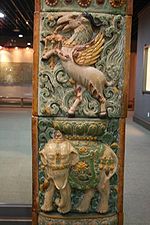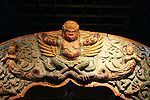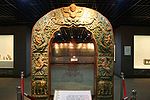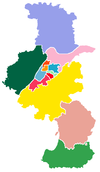- Porcelain Tower of Nanjing
-
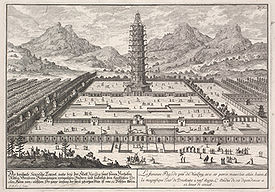 The Porcelain Pagoda, as illustrated in Fischer von Erlach's Plan of Civil and Historical Architecture (1721)
The Porcelain Pagoda, as illustrated in Fischer von Erlach's Plan of Civil and Historical Architecture (1721)
The Porcelain Tower (or Porcelain Pagoda) of Nanjing (Chinese: 南京陶塔; pinyin: Nánjīng Táotǎ, or Chinese: 琉璃塔; pinyin: Liúlí Tǎ), also known as Bao'ensi (meaning "Temple of Gratitude"; Chinese: 大报恩寺, Da Bao'en Si), is a historical site located on the south bank of the Yangtze in Nanjing, China. It was a pagoda constructed in the 15th century during the Ming Dynasty, but was mostly destroyed in the 19th century during the course of the Taiping Rebellion. In 2010 Wang Jianlin, a Chinese businessman, donated one billion yuan (US$156.3 million) to the city of Nanjing for its reconstruction of the pagoda. This is reported to be the largest single personal donation ever made in China.[1]
Contents
History
The original blocks of the Nanjing Tower's arched door, now pieced back together and on display at the Nanjing MuseumThe Porcelain Tower of Nanjing was designed during reign of the Yongle Emperor (r. 1402-1424) shortly before its construction, in the early 15th century. It was first discovered by the Western world when European travelers like Johan Nieuhof visited it,[2] sometimes listing it as one of the Seven Wonders of the World. After this exposure to the outside world, the tower was seen as a national treasure to both locals and other cultures around the world.[3]
In 1801, the tower was struck by lightning and the top three stories were knocked off, but it was soon restored. The 1843 book The Closing Events of the Campaign in China by Granville Gower Loch contains a detailed description of the tower as it existed in the early 1840s. In the 1850s, the area surrounding the tower erupted in civil war as the Taiping Rebellion reached Nanjing and the Taiping Rebels took over the city. They smashed the Buddhist images and destroyed the inner staircase to deny the Qing enemy an observation platform. American sailors reached the city in May 1854 and visited the hollowed tower. In 1856, the Taiping destroyed the tower either in order to prevent a hostile faction from using it to observe and shell the city[4] or from superstitious fear of its geomantic properties.[5] After this, the tower's remnants were salvaged for use in other buildings, while the site lay dormant until a recent surge to try to rebuild the landmark.
Description
The original blocks of the Nanjing Tower's arched door, now pieced back together and on display at the Nanjing MuseumThe tower was octagonal with a base of about 97 feet (30 m) in diameter. When it was built, the tower was one of the largest buildings in China, rising up to a height of 260 feet (79 m) with nine stories and a staircase in the middle of the pagoda, which spiraled upwards for 184 steps. The top of the roof was marked by a golden pineapple. There were original plans to add more stories, according to an American missionary who in 1852 visited Nanjing. There are only a few Chinese pagodas that surpass its height, such as the still existent 275-foot-tall (84 m) 11th-century Liaodi Pagoda in Hebei or the no longer existent 330-foot-tall (100 m) 7th-century wooden pagoda of Chang'an.
The tower was built with white porcelain bricks that were said to reflect the sun's rays during the day, and at night as many as 140 lamps were hung from the building to illuminate the tower. Glazes and stoneware were worked into the porcelain and created a mixture of green, yellow, brown and white designs on the sides of the tower, including animals, flowers and landscapes. The tower was also decorated with numerous Buddhist images.
References
- ^ "Wanda chairman makes largest donation in China's history". People's Daily Online. 10 November 2010. http://english.peopledaily.com.cn/90001/90782/7194802.html. Retrieved 10 September 2011.
- ^ Digital Library for the Decorative Arts and Material Culture [1]
- ^ Porcelain Tower of Nanjing - Seven Wonders of the Medieval Mind
- ^ Jonathan D. Spence. God's Chinese Son, New York 1996
- ^ Williams, S. Wells. The Middle Kingdom: a Survey of the Geography, Government, Literature, Social Life, Arts, & History of the Chinese Empire & its Inhabitants, Vol. 1. Scribner (New York), 1904.
External links
- http://www.history.com/minisites/sevenwonders/images/seven-medieval-wonders-procelain-tower.jpg
- The Closing Events of the Campaign in China by Granville Gower Loch. London 1843.
Coordinates: 32°4′49.26″N 118°43′48.78″E / 32.08035°N 118.7302167°E
Categories:- 15th-century architecture
- Buildings and structures in Nanjing
- Chinese porcelain
- Destroyed landmarks
- Towers in China
- Chinese culture
Wikimedia Foundation. 2010.


